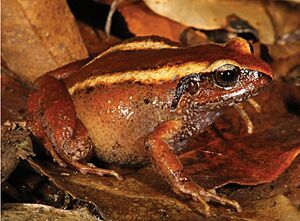Arthroleptis francei facts for kids
Quick facts for kids Arthroleptis francei |
|
|---|---|
 |
|
| Conservation status | |
| Scientific classification | |
| Synonyms | |
|
Arthroleptis adolfifriederici francei Loveridge, 1953 |
Arthroleptis francei is a type of frog that belongs to the family Arthroleptidae. You can find this frog in Mount Mulanje in southern Malawi. It also lives in Mount Namuli and Mount Mabu in northern Mozambique. People sometimes call this frog the Ruo River screeching frog or France's squeaker.
About Its Name
The scientific name francei was given to honor Mr. F. H. France. He was a young forestry officer who sadly lost his life trying to cross the Ruo River. This river was very close to where this frog species was first found. Arthur Loveridge, the person who named the frog, wanted France's name to be remembered. He wanted it linked to the forests that France loved and worked hard to protect.
What It Looks Like
Male Arthroleptis francei frogs are usually about 25 to 30 millimeters (about 1 inch) long. Females are a bit bigger, measuring 29 to 43 millimeters (about 1.1 to 1.7 inches) from their snout to their rear. The frog's head is not wider than its body.
It has a clear eardrum, called a tympanum, which is about half the size of its eye. Its fingers and toes do not have webbing. However, their tips are a little swollen. The frog's back is a dark brownish-red color. It has a dark black stripe that runs from its nostril, over its eye, and down to its forearm. There is also a black bar between its eyes. You might also see dusky (dark and cloudy) markings on its back, sides, and legs.
Where It Lives and How It's Protected
This frog lives in mountain forests. This includes high-altitude cedar forests and areas with pine trees. It can also be found in grasslands next to wooded areas, but it prefers the forests. It lives at elevations from 700 to 2500 meters (about 2,300 to 8,200 feet) above sea level. It often hides in leaf litter on the ground but can also climb trees.
Some things threaten this frog's home. These include cutting down trees (logging) and planting too many pine trees. Small farms are also growing, and people sometimes use fire to manage grasslands. These actions can harm the frog's habitat. Luckily, some parts of its home are protected. For example, the Mount Mulanje Biosphere Reserve helps keep some of its living areas safe.


